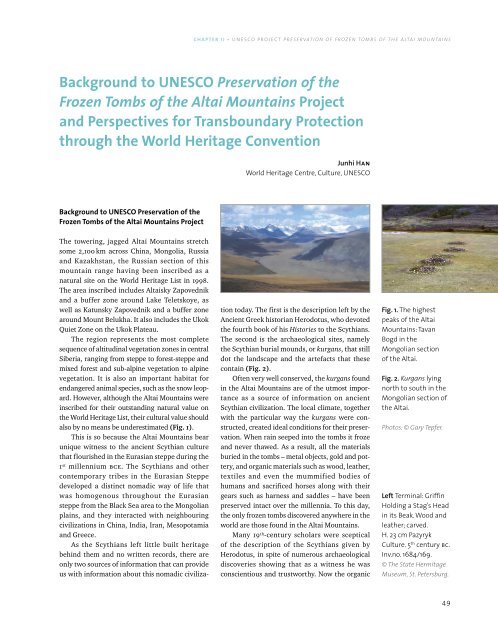Scythian Culture - Preservation of The Frozen Tombs of The Altai Mountains (UNESCO)
You also want an ePaper? Increase the reach of your titles
YUMPU automatically turns print PDFs into web optimized ePapers that Google loves.
CHAPTER II • <strong>UNESCO</strong> PROJECT PRESERVATION OF FROZEN TOMBS OF THE ALTAI MOUNTAINS<br />
Background to <strong>UNESCO</strong> <strong>Preservation</strong> <strong>of</strong> the<br />
<strong>Frozen</strong> <strong>Tombs</strong> <strong>of</strong> the <strong>Altai</strong> <strong>Mountains</strong> Project<br />
and Perspectives for Transboundary Protection<br />
through the World Heritage Convention<br />
Junhi Han<br />
World Heritage Centre, <strong>Culture</strong>, <strong>UNESCO</strong><br />
Background to <strong>UNESCO</strong> <strong>Preservation</strong> <strong>of</strong> the<br />
<strong>Frozen</strong> <strong>Tombs</strong> <strong>of</strong> the <strong>Altai</strong> <strong>Mountains</strong> Project<br />
<strong>The</strong> towering, jagged <strong>Altai</strong> <strong>Mountains</strong> stretch<br />
some 2,100 km across China, Mongolia, Russia<br />
and Kazakhstan, the Russian section <strong>of</strong> this<br />
mountain range having been inscribed as a<br />
natural site on the World Heritage List in 1998.<br />
<strong>The</strong> area inscribed includes <strong>Altai</strong>sky Zapovednik<br />
and a buffer zone around Lake Teletskoye, as<br />
well as Katunsky Zapovednik and a buffer zone<br />
around Mount Belukha. It also includes the Ukok<br />
Quiet Zone on the Ukok Plateau.<br />
<strong>The</strong> region represents the most complete<br />
sequence <strong>of</strong> altitudinal vegetation zones in central<br />
Siberia, ranging from steppe to forest-steppe and<br />
mixed forest and sub-alpine vegetation to alpine<br />
vegetation. It is also an important habitat for<br />
endangered animal species, such as the snow leopard.<br />
However, although the <strong>Altai</strong> <strong>Mountains</strong> were<br />
inscribed for their outstanding natural value on<br />
the World Heritage List, their cultural value should<br />
also by no means be underestimated (Fig. 1).<br />
This is so because the <strong>Altai</strong> <strong>Mountains</strong> bear<br />
unique witness to the ancient <strong>Scythian</strong> culture<br />
that flourished in the Eurasian steppe during the<br />
1 st millennium bce. <strong>The</strong> <strong>Scythian</strong>s and other<br />
contemporary tribes in the Eurasian Steppe<br />
developed a distinct nomadic way <strong>of</strong> life that<br />
was homogenous throughout the Eurasian<br />
steppe from the Black Sea area to the Mongolian<br />
plains, and they interacted with neighbouring<br />
civilizations in China, India, Iran, Mesopotamia<br />
and Greece.<br />
As the <strong>Scythian</strong>s left little built heritage<br />
behind them and no written records, there are<br />
only two sources <strong>of</strong> information that can provide<br />
us with information about this nomadic civilization<br />
today. <strong>The</strong> first is the description left by the<br />
Ancient Greek historian Herodotus, who devoted<br />
the fourth book <strong>of</strong> his Histories to the <strong>Scythian</strong>s.<br />
<strong>The</strong> second is the archaeological sites, namely<br />
the <strong>Scythian</strong> burial mounds, or kurgans, that still<br />
dot the landscape and the artefacts that these<br />
contain (Fig. 2).<br />
Often very well conserved, the kurgans found<br />
in the <strong>Altai</strong> <strong>Mountains</strong> are <strong>of</strong> the utmost importance<br />
as a source <strong>of</strong> information on ancient<br />
<strong>Scythian</strong> civilization. <strong>The</strong> local climate, together<br />
with the particular way the kurgans were constructed,<br />
created ideal conditions for their preservation.<br />
When rain seeped into the tombs it froze<br />
and never thawed. As a result, all the materials<br />
buried in the tombs – metal objects, gold and pottery,<br />
and organic materials such as wood, leather,<br />
textiles and even the mummified bodies <strong>of</strong><br />
humans and sacrificed horses along with their<br />
gears such as harness and saddles – have been<br />
preserved intact over the millennia. To this day,<br />
the only frozen tombs discovered anywhere in the<br />
world are those found in the <strong>Altai</strong> <strong>Mountains</strong>.<br />
Many 19 th -century scholars were sceptical<br />
<strong>of</strong> the description <strong>of</strong> the <strong>Scythian</strong>s given by<br />
Herodotus, in spite <strong>of</strong> numerous archaeological<br />
discoveries showing that as a witness he was<br />
conscientious and trustworthy. Now the organic<br />
Fig.1.<strong>The</strong> highest<br />
peaks <strong>of</strong> the <strong>Altai</strong><br />
<strong>Mountains</strong>: Tavan<br />
Bogd in the<br />
Mongolian section<br />
<strong>of</strong> the <strong>Altai</strong>.<br />
Fig. 2. Kurgans lying<br />
north to south in the<br />
Mongolian section <strong>of</strong><br />
the <strong>Altai</strong>.<br />
Photos: © Gary Tepfer.<br />
Left Terminal: Griffin<br />
Holding a Stag’s Head<br />
in its Beak. Wood and<br />
leather; carved.<br />
H. 23 cm Pazyryk<br />
<strong>Culture</strong>. 5 th century bc.<br />
Inv.no. 1684/169.<br />
© <strong>The</strong> State Hermitage<br />
Museum, St. Petersburg.<br />
49
















